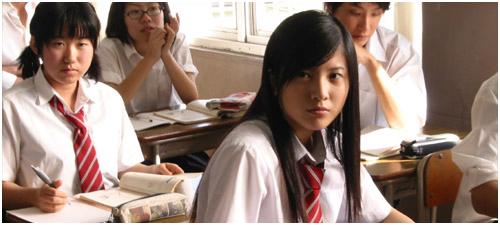
Noriko's Dinner Table (Movie Review)
Sono Sion is a poet and at one time a counter culture phantom hero, of sorts, more in the Bukowski mold than the Ginsberg model from what I can ascertain. His 1997 performance art piece Tokyo GAGAGA was a series of elaborate blasts of protest poetry and performance played out in various high traffic areas of Tokyo. Bold , open, and extemporaneous were all words used to describe Tokyo GAGAGA, they may also be the most apt descriptions of Sono’s break-out film “Suicide Club” (2001). It is a fearless genre-breaker that unspools like a densely layered slam piece. Suicide Club is fun, unnerving, inventive and at times downright odd.
The film centers on a chain of events seemingly set off by the mass suicide of 54 Japanese school girls at Shinjuku station in Tokyo. The subsequent investigation yields a BBS (haikyo.com) where the girls involved connected, and where their deaths along with those of other teens are being recorded in red and white dots. This is as straightforward as “Suicide Club” ever gets. The desperate adults and police race around trying to halt the growing phenomenon, while searching for someone to hold accountable for the tragedies. By the end of the film, most viewers have more questions than hard answers and Sono has a movie that is electric with the anxieties of everyone involved.
If “Suicide Club” is performance poetry then “Noriko’s Dinner Table” (2005), it's companion piece, is an elegy.
Noriko is a disaffected 17 year old girl living in a rural fishing community of Toyokawa with her parents, Tetsuo and Taeko, and her 15 year old sister, Yuka. The family is a grouping of separate souls rife with uncommunicated or unrecognized needs. Noriko wants to leave the stifling smallness of Toyokawa for Tokyo. Her father believes the town to be ideal and refuses to entertain his daughter’s discontentment. The seams burst for Noriko after discovering haikyo.com and befriending a group of girls that she feels are living a more ‘connected’ life. One night during a blackout she packs her bags and leaves for Tokyo to meet one of her new internet friends, Kumiko. This sets in motion a series of events that track the dissolution of the family and the deepening of the themes and ideas touched upon in Suicide Club. Without giving too much away, Kumiko helps Noriko to craft a life more closely resembling her ideals. Yuka eventually follows her sister and their father sets off in search of them.
The puzzles and mysteries of “Noriko’s Dinner Table” are much richer and more layered than those of “Suicide Club”. The rub here for fans of the first film is that beyond the common plot threads, there is very little similarity, especially where style is concerned. The film contains virtually none of the wild immediacy of its predecessor. Its black humor runs a distant third to the plight of its characters and the complexity of their dilemmas. In terms of structure the film bounces through time and perspective to a degree that may well be difficult for some to follow. The perceived relationship of the characters to the events in “Suicide Club” changes as the story progresses and the lyrical bleeding together of dream, ideal, emotional truth and the reality of the circumstances require the viewer to feel the film rather than solve it.
With “Noriko’s Dinner Table” Sono takes us through each of the character’s struggles from inside their emotional realities. This is done partially by an omnipresent voiceover narration that shifts speakers and perspectives. The narration is confusing and superfluous, often telling us exactly what we are seeing on screen. It is one of those big ‘no-no’s’ screenwriting-wise, but it’s neither a hammer nor a crutch. Sono is not interested in spoon feeding. Rather, his use of this Voice over device seems to be to keep us from finding a character to side with. Ulteriorly, the narration undermines our ability to ruminate on bigger questions until he is ready to have us do so. The narration also brings us into how each character embodies one of the central ideas, ‘avoiding pain’. What everybody at Noriko’s Dinner Table shares is the inability to deal with the dialectic. They cannot see that they are both lion and rabbit, simultaneously hard and soft. As Yuka decries at the end of the film,
'All I see are a bunch of Lions.'
All of them take turns creating new realities to offset the pain they cannot bear to feel. The identities they are trying to salvage, create, or destroy are the only barrier between them and the abjection of their circumstance. They are also is also the source of their pain.
This is where the film is particularly effective and rewarding. Sono never sacrifices the emotional pay-offs for the sake of shock or distortion. The humanity of everyone in the story’s core grows more evident as they drift further into the cold chaos of their fashioned realities. What is more, while giving us these detailed internal geographies the director holds fast to the larger notions of the folly of control and the weight of connections that out distance our comprehension. Sono Sion cites Scorsese and Cassavettes as influences, and while those are evident in places, his surreal forays into emotional imagery and cognitive dissonance are more reminiscent of Michel Gondry than anyone else.
Sono’s poetic background as well his provocative showmanship are evident throughout this film. He’d rather have us feel than know, hoping that by the end we know because we feel. For those looking for explanations, some of the questions of “Suicide Club” are answered, some linger and some new questions are posed. It is a long and deliberately paced film with a misleading blood-spattered ad campaign. That said it is also a trip well worth-taking; largely because the family's journey is every bit as bewildering and fractious as what we might experience internally when dealing with our own family dynamics.

